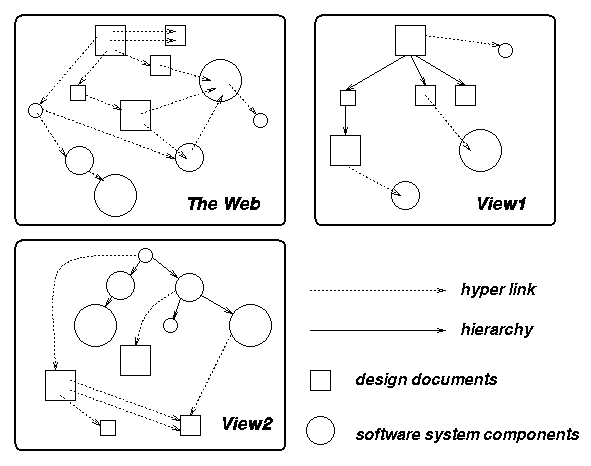
Figure 1: Motivating Examples




Journal reference: Computer Networks and ISDN Systems, Volume 28, issues 7–11, p. 1243.
The World Wide Web ([3]) is a huge, distributed information store. It has been very successful in providing information to users all over the world. The development of protocols such as the Common Gateway Interface ([10]), and technologies such as proxies [4] [9], have enabled construction of numerous web-based applications, such as collaborative editors and annotation systems.
However, the information retrieved from the web is presented to users on an as-is basis without a "big picture" that associates the structure of the data with the specific application. In other words, users always view the web according to the low-level structure determined by hyperlinks within the web pages that contain the actual information.
A Web View is an abstract structure imposed on the web, rather than defined entirely within the web pages themselves. Different users might have different views of the same subweb; the same user might have different views at different times, appropriate to the task at hand.
We show through some motivating examples (Figure 1) that dynamically customizable web views would be very useful. We present an architecture (Figure 2) and an implementation (Figure 7) that integrates object-oriented database (OODB) technology with the web to support views that can be dynamically customized for web-based application systems.
Say one physicist wants to use the experimental data posted on the web by another physicist, but in some different way. That is, the data is hyperlinked in a structure that matches the author's understanding of the logical relationships but the reader's perspective is different. The reader should then create a new view over the data to restructure and/or reformat the pages, for human browsing and/or input to computational tools.
Some healthcare systems use WWW to store patient information such as personal data, diagnoses, healthcare history, test results, physician notes, etc. Patients may be admitted to different hospitals within even a short period concerned with a single illness or injury, so logically centralized information may be distributed over multiple websites. Patient data should not be identically visible to all (authorized) users: administrative personnel do not need to see CT images, whereas medical researchers should mine histories and clinical trials anonymously. Thus information should be structured differently for each user role and/or application, while minimizing expensive duplication of information.

In a software development environment that uses WWW for storage of design documents and source code, the designers and programmers would like to view the software system under development in different ways. The designers should see the system primarily as chapters and sections of design documents, perhaps with hyperlinks to corresponding code. Programmers, on the other hand, should see the system in terms of subsystems, modules and source files, perhaps with hyperlinks to relevant fragments of the design. These two sets of objects may be logically related in hierarchical structures illustrated in Figure 1.
Finally, suppose the web is used in a training system where an experienced user sets up a "trail" of web visits and operations for novice users to exercise. The view then consists of a temporal series of visits to web pages and encapsulates the operations (input) of the "teacher". To minimize authoring effort, the view might be constructed dynamically by tracing the experienced user's web traversal.
The main way to provide customized views of the web is currently through "homepages" with hyperlinks to web pages of interest to the homepage author. A homepage may include queries to search engines (Alta Vista, Lycos, Yahoo, etc.), with limited tracking of web changes, but is relatively static with the hardcoded URLs generally modified by hand. Homepages alone cannot provide application-specific (and thus more powerful) query ability.
We identify some essential requirements for dynamically customizable web views:
The architecture presented in this paper uses Object-Oriented Databases (OODB) to perform the core functionalities including view and meta-information storage and query processing. OODBs provide a suitable data model for WWW artifacts: web data is represented by attributed objects with referential and composite relationships, in addition to page content and embedded hyperlinks. Also, the rich set of associative and/or navigational functions provided by most OODBs enables powerful search capabilities. Our architecture does not require modifications to current Web protocols or browsers.
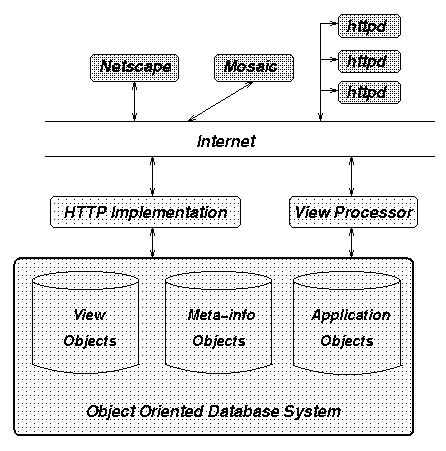
The system architecture is the key to supporting dynamically customizable views on the web. Our architecture is shown in Figure 2. It consists of three major components:
The system architecture is augmented
by embedded methods for web objects. An embedded method is
defined in the form of an "unknown tag" in HTML. The HTML
specification defines that "unknown tags" should be ignored by
browsers, therefore they will not be shown via a normal access. But
when the web object is accessed by a View Processor, it may understand
the information carried by the embedded methods -- which may be
an attribute value that describes characteristics of the web object or
an update operation on either the OODB or the web object itself (see
below). Figure 3
shows a simple example.
Embedded methods is one way to turn web pages into Web
Objects. Currently, most web pages are simply hyperlinked passive
data. In order to treat the web as a huge OODB, we need to add on
attribute values and operation methods as in other object systems.
In particular, embedded methods provide a way to define
customized operations. In Figure 3,
NewComment is implemented through sending email to the
author; alternatively, the cgi-bin could do other things such as
appending the comment to the page. The embedded methods should
be written in some format expected by the View Processor. For
example, the View Processor needs to identify the keywords
from and content and give them appropriate meanings
(in this case, the person who gives the comment and the comment
itself). Different View Processors may interpret these methods
differently (especially how to define parameters), which is a problem
when the web page is used by arbitrary View Processors. Therefore, we
propose to use the system keyword (such as in the NewComment
example) to distinguish different protocols that may be understood by
one or more Web View systems.
A Web View system goes through a number of main steps to construct
a view:
Request Acceptance: The HTTP Implementation receives a
request from a client browser in the form of a GET or POST method.
GET and POST are the two major commands accepted by HTTP servers. In
our approach, GET methods are usually used to obtain pre-defined views
and POST methods to modify views. The HTTP implementation translates
the requests into OODB queries or update commands, and forwards the
queries or updates to the OODB or the View Processor depending on the
type of the request.
View Retrieval/Update: The OODB gets requests from the HTTP
Implementation and retrieves/updates view objects. If a request
updates a view, the OODB informs the HTTP Implementation of the result
and replies to the client browser, finishing the operation.
Otherwise, the next two steps are invoked.
View Construction: After the view object is retrieved from
the objectbase, it is sent to the View Processor, which parses the
view definition and pulls in necessary data from either the local
objectbase or the web. The View Processor queries the objectbase for
the source location of the objects and either contacts local
objectbases for application objects or the appropriate web site for
remote web objects.
Reply: The View Processor then gives the processed view back
to the HTTP Implementation, and the processed view is ultimately sent
to the client browser.
The following is an example of how view objects and meta-infomation objects
are defined:
In the objectbase, a view definition is stored for each view instance. The
content attribute then contains the view definition written in
enhanced HTML. The following is an example of a view definition:
When the above view is queried, the View Processor reads the view
definition and exeutes the queries as they are read, and inserts information
when print commands are encountered. In this case the actual URLs
that will receive the doc_root object and chapter objects will be inserted.
However, the URLs point to objects (in this case MetaInfo objects) in the
objectbase instead of their real URL. The reason is we need to insert other
links into the web page before it is shown to the user. This is used to
help the situations where there are no hyperlinks in the original web object.
For example, if there are no hyperlinks from each Chapter to the modules they
describe, we can add them when the MetaInfo objects are referenced.
A highly centralized architecture would use an OODB to store
virtually all the application-oriented information about the web
objects in the corresponding meta-information objects in the database.
Hierarchical and other relationships among meta-information objects
reflect externally onto the underlying web objects. The web objects
themselves are totally passive. They may provide some information to
the OODB via embedded methods, but are not bound to, and in any
case the OODB is not informed when they change. Therefore the OODB
has to search for changes (including location movement) in the web
crawling style of search engines. Cognizance of change is necessary
when some meta-information is derived from the web objects' content or
context (e.g., file system information like location, owner,
permissions, creation time, last modification, etc.). Figure 4 illustrates this kind of system:
The main advantage of this model is simplicity. It requires
minimum support from the web object owners: there need not be any
embedded methods at all (although any that exist can still be
exploited). The main disadvantage is lack of scalability. Depending
on the application, the objectbase might manage a huge number of web
objects, each with a substantial amount of meta information, and be
responsible for detecting all their changes.
In a highly distributed architecture, the OODB degenerates to
nothing and the View Processor might be just a slightly enhanced proxy
server, as shown in Figure 5. All information
about web objects is stored within their contents, and all
relationships as internal hyperlinks.
The main advantage of this model is scalability, since no
information about web objects is duplicated. On the other hand, this
approach depends on the web object owners to carefully program their
web objects with embedded methods, if they are to achieve dynamically
customizable views. This may be unrealistic, except when most web
pages of interest are owned by technically-oriented persons - for
example, in a software development environment where the users are
designers, programmers and quality assurance personnel.
The third variant is a hybrid in between the other two. It uses
OODBs to store meta information about web objects and also benefits
from those web objects that are carefully programmed through
embedded methods. The architecture is shown in Figure 6.
In this example, there are two independent OODBs operating on the
same subset of the web. They store view objects and meta-information
objects in order to provide rich facilities independent of the web
objects. As in the first variant, an OODB object may point to a
set of objects by maintaining a URL to a directory or a index
page, increasing scalability (a one to one relationship between OODB
objects and web pages is too costly when the number of web pages
becomes very large).
But now, the web objects can be assumed to
contain special links defined by embedded methods, which we call
backlinks, to all those OODB objects that contain their
meta-information. The backlinks could be implemented simply as
URLs because the OODB objects are accessible via HTTP.
Backlinks are useful for propagating web object changes among
all OODBs that share it. When a web object is accessed through any
one of the OODBs, its backlinks can be automatically followed
so all OODBs that reference the web object can update their
meta-information.
<TITLE> Example of Embedded Methods </TITLE>
<H1> Example of Embedded Methods </H1>
<EMETH type=attribute name=author
value=jyang@cs.columbia.edu>
<EMETH system=DKWEB type=operation name=NewComment
npara=2 para1=from para2=content method=GET
operator=http://www.cs.columbia.edu/~jyang/cgi-bin/sendmail.cgi>
...
# The class definition of View and MetaInfo
# They are inherited by specialized View and MetaInfo classes
View :: superclass ENTITY;
owner : User;
public : boolean; # is this view public readable?
content : text; # the view definition in enhanced HTML
end
MetaInfo :: superclass ENTITY;
author : string; # the email of author
URL : string;
end
# example of subclasses of MetaInfo
DocRoot :: superclass MetaInfo;
system : string; # the system that this document is for
chapters : set_of Chapter;
end
Chapter :: superclass MetaInfo;
chapter_number : integer;
module : link Module; # which module is related to it
sections : set_of Section;
end
<TITLE> Example of View Definition </TITLE>
<H1> Example of View Definition </H1>
<HR>
This example view is a view to the software engineering environment.
The view contains the chapters and sections of the design document.
<P>
<DKOV_QUERY bind doc_root DOC_ROOT where (doc_root.system == "samplesys");>
<DKOV_QUERY bind chap CHAPTER where (member doc_root.chapters);>
The document of <DKOV_QUERY print doc_root> system contains the
following chapters:
<DKOV_QUERY print chap>
Variants
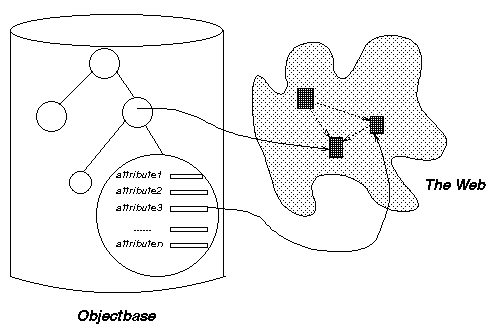
Figure 4: Meta-information Derived from
the Web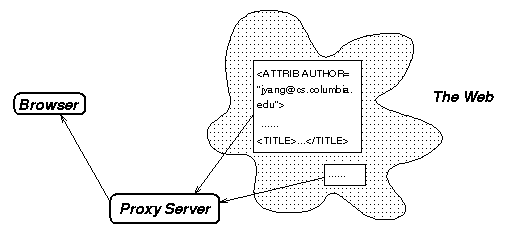
Figure 5: View Processor as Enhanced
Proxy Server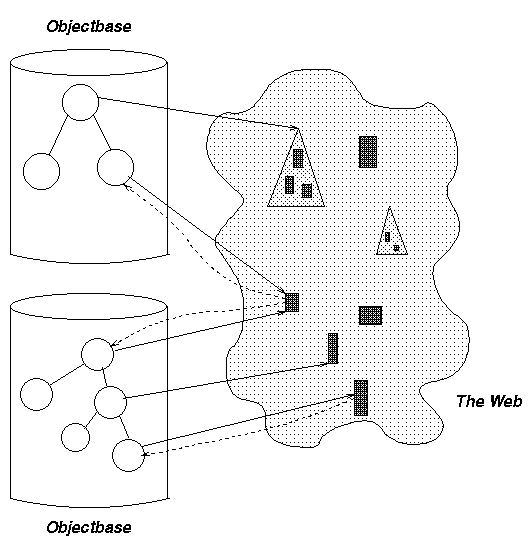
Figure 6: Two Independent OODBs
Operating on the Web Implementation Issues
In a CGI implementation, a standard HTTP server is a "front" for the OODB, with the CGI protocol used to submit objectbase queries. These queries may in turn generate further requests to other HTTP servers for web objects. The system is decomposed into several cgi-bins, each responsible for certain kinds of queries or updates. The advantage is the system is highly flexible in the sense that changing one or more of the cgi-bins easily changes the behaviour of the system. Also, commercial HTTP servers can be used so that their special features (e.g., secure HTTP) are still available.
In a server implementation, a standard HTTP server is not used for the HTTP Implementation, which is instead targeted to the specific application. This approach also has its advantages. Some possibly essential features of HTTP (such as the PUT method) are not implemented by most servers. It is generally more efficient, e.g., when a simple request is received, it need not spawn another operating system process or thread (to execute a CGI-bin) but just performs the request by itself. Perhaps even the OODB and/or View Processor are incorporated directly into the HTTP server. This may, of course, place an unacceptable load on the server process.
We also include the case of an HTTP proxy server. A proxy server is an intermediary designated by the client browser so that every HTTP request goes to it, and then the proxy fetches the URL from a conventional server and replies to the browser. A proxy server has the unique advantage of enabling tracking of clients who access web objects not mirrored in the objectbase. Because each access goes through the proxy server, the proxy can modify the web objects sent back to the browser. For example, one useful modification may be adding an extra form at the end of each web object to allow the user to add that web object into the objectbase on the fly.
In applications where annotations or co-authoring is of interest, web objects may be the target of update actions from the View Processor. Although like other web objects, they are not stored in the local objectbase, per se, they may be considered part of the system (web objects are normally updated outside the system using various editing and file system facilities). To provide flexible, user-oriented schemas for updating what we call semi-local web objects, embedded methods are very useful.
For example, in a co-authoring system, each co-author might be allowed to overwrite the original web page. In this case, the web object would include an embedded method, recognized by the View Processor but not by a normal browser, to indicate the permitted update method. One possible embedded method would include the URL of a cgi-bin that simply replaces the page; a better method would first save the previous version using some version control tool like RCS or SCCS.
In an annotation system, constructing a comment might generate a new web object hyperlinked to the commented page. The latter might or might not be modified, by its embedded method, to include a hyperlink to the annotation; if not, the reference to the set of annotations could be represented instead in the OODB, perhaps with one meta-information object encapsulating the collection of annotations on the same original web object (perhaps covering also annotations on the annotations). In any case, the embedded method would need to specify where to store the new web object.
Using embedded methods to customize the operations allowed on a web object provides additional flexibility beyond that afforded by the PUT method (designed to write web objects), which is left unimplemented by most HTTP servers.
Another advantage of embedded methods is that the owner of the web object can access the objectbase via the embedded methods. The simplest case is the backlinks discussed above. In general, the web object owner programs queries or update commands and the View Processor performs these objectbase operations whenever the web object is accessed. Note this provides a way for a web object owner to parameterize the operation of complex embedded methods according to the information currently stored in the objectbase -- probably the ultimate in dynamic customization.
We have developed a sample implementation using a home-grown Object Oriented Database called Darkover [1] (which was originally intended for an unrelated purpose [2]). The sample system supports a shared web navigation and annotation system. It provides the following features:
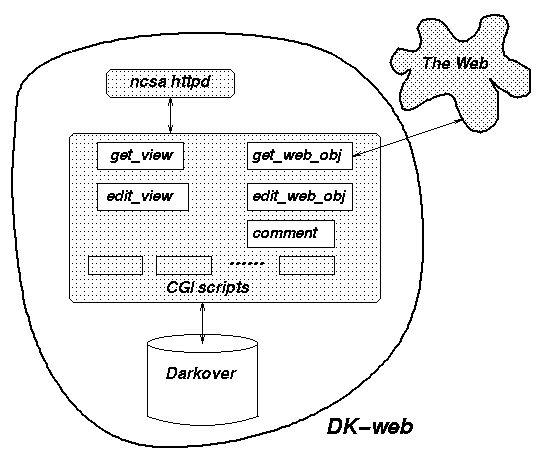
The implementation is illustrated in Figure 7. Several cgi-bin scripts perform the main functions of the system, and the Darkover objectbase supports a rich object-oriented data model and a sophisticated ad hoc query language (used in the scripts).
The get_view cgi-bin queries Darkover to find a view. In a view, each web object is shown as a hyperlink with some meta-information (e.g., last visited, size, etc.). When the user wants to retrieve the web object, he/she follows the hyperlink -- which is a reference to the get_web_obj cgi-bin. get_web_obj first looks at the objectbase to see if this is a local object, and fetches it from the home website if not. Then the script also parses the page and modifies all its hyperlinks so that further references are re-directed to this script. This ensures tracking of all browser accesses to web objects.
get_web_obj also adds three forms to the end of the page so that the user can:
The edit_web_obj cgi-bin is called when the edit form at the bottom of a web object is submitted. It checks whether the web object defines its own embedded method for update: If so, the edited source is provided to the method as one of its parameters. Otherwise, the modified version is stored in the objectbase. Later on, when other references to this web page are made, the modified version appear attached to the end of the original page via a hyperlink so that other users can see the modification as well (but the original page is not replaced).
Comments are stored in the objectbase as descendants of the composite meta-information objects mirroring the web object. But if the web object defines an embedded method named NewComment, all comments are forwarded to the owner (or otherwise handled) by that method.
Ockerbloom proposed the Typed Object Model [6] alternative to MIME types whereby object types exported from anywhere on the Internet can be registered in "type oracles", specialized servers that may communicate among themselves to uncover the definitions of types registered elsewhere. Web clients who happen upon a type they do not understand can ask one of the type oracles how to convert it into a known supertype. Such typing facilities would nicely complement our representation of web objects in OODBs, and would enrich the modeling approach.
OreO [7] is a proxy server-based architecture providing general-purpose information filtering between web browsers and HTTP servers. It presents a novel way to support static views and interoperability among the views. OreO's focus is on "constructing highly specialized transducers that can be composed to produce more sophisticated aggregate behavior". The aggregate behavior, however, does not address the dynamic property of the web views presented in this paper.
ComMentor [8] supports sharing of in-place annotations attached to arbitrary web pages. The approach depends on specialized browsers so that a more complicated client/server communication protocol can be leveraged. We noted some disadvantages of customized browsers above. The ComMentor demo we observed depends on the remote display feature of X11 Windows (xhost). This has two disadvantages: first of all, PC users without an X-server simply cannot display the browser. Second, allowing remote access to users' displays introduces many possible security holes, e.g., one could use commands like xwd to dump a user's screen, write an X program to steal all keystrokes, etc.
Java [11] supports the programming for the Internet in the form of platform-independent Java applets. It is quite different from what embedded method does. The embedded methods are used to supports web-object side operations. It is executed on the machine where the web object is from, while the Java applets are executed in the reader's machine. A roundabout approach to implement the Embedded Methods using Java is to have a front-end Java applet that talks to a server on the machine where the web object is from. But since it is less efficient in execution and more time consuming for the web-object owners to write the applet and the server, it is not recommended unless sophisticated user interaction is needed for the method.
We described an architecture for integrating OODBs with WWW to support dynamically customizable views on the web. The architecture depends on several new ideas, most notably embedded methods. We discussed architectural alternatives and implementation issues, and briefly sketched our implementation of dkweb based on a conventional OODB. The OODB (i.e., Darkover) is not altered in any way to support dkweb, which means this approach could apply to an arbitrary OODB.
The views and conclusions contained in this document are those of the authors and should not be interpreted as representing the official policies, either expressed or implied, of the US or NYS government, ARPA, Air Force, NSF, or NYSSTF.
Gail E. Kaiser
is a tenured Associate Professor of Computer
Science and the Director of the Programming Systems Laboratory
at Columbia University. She was as an NSF Presidential Young
Investigator in Software Engineering, and has published about 90
refereed papers in collaborative work, software development
environments, software process, extended transaction models,
object-oriented languages and databases, and parallel and
distributed systems. Prof. Kaiser is an associate editor of the
ACM Transactions on Software Engineering and Methodology and has
served on about 25 program committees. She received her PhD and
MS from CMU and her ScB from MIT.
http://www.cs.columbia.edu/~kaiser/